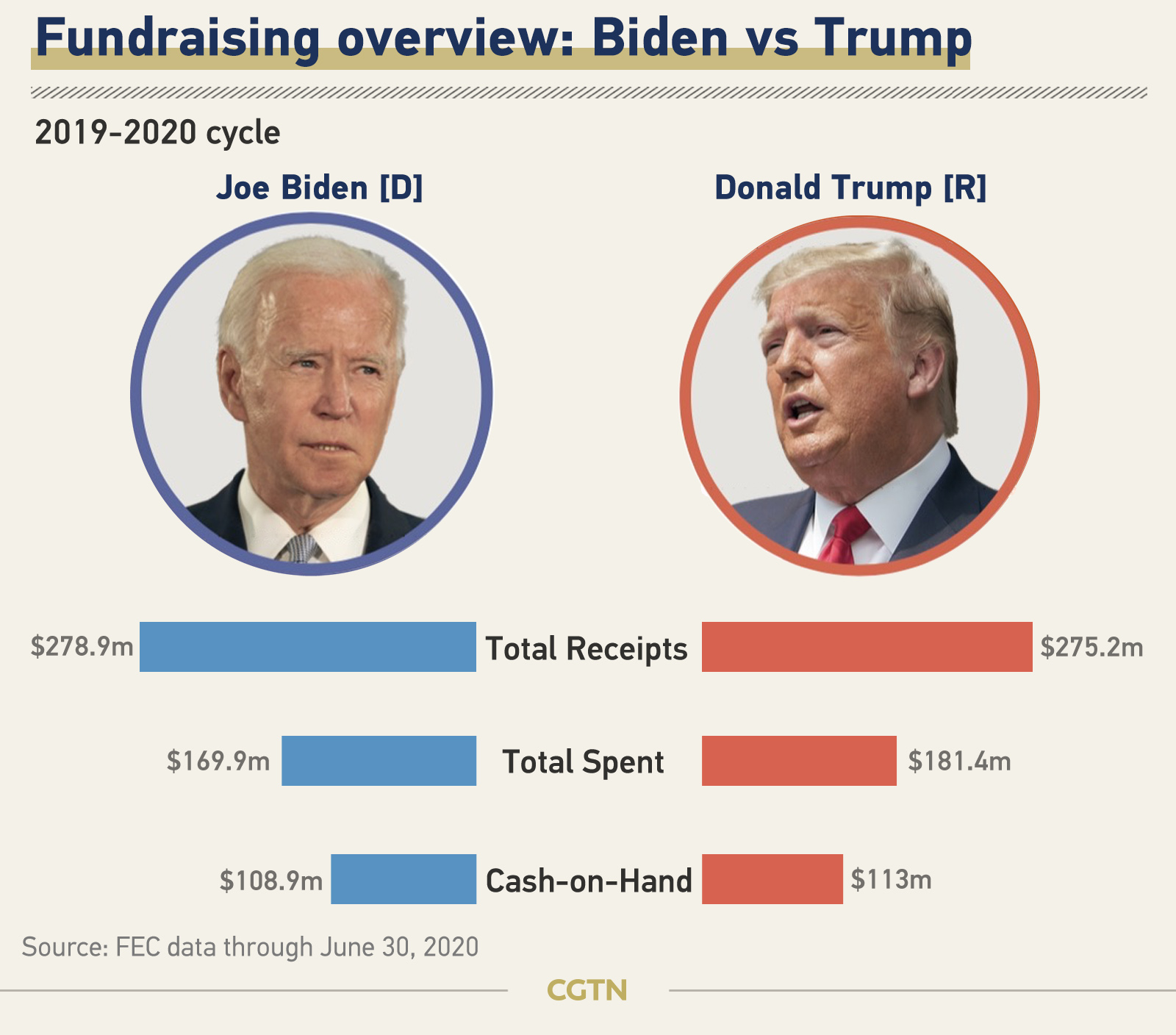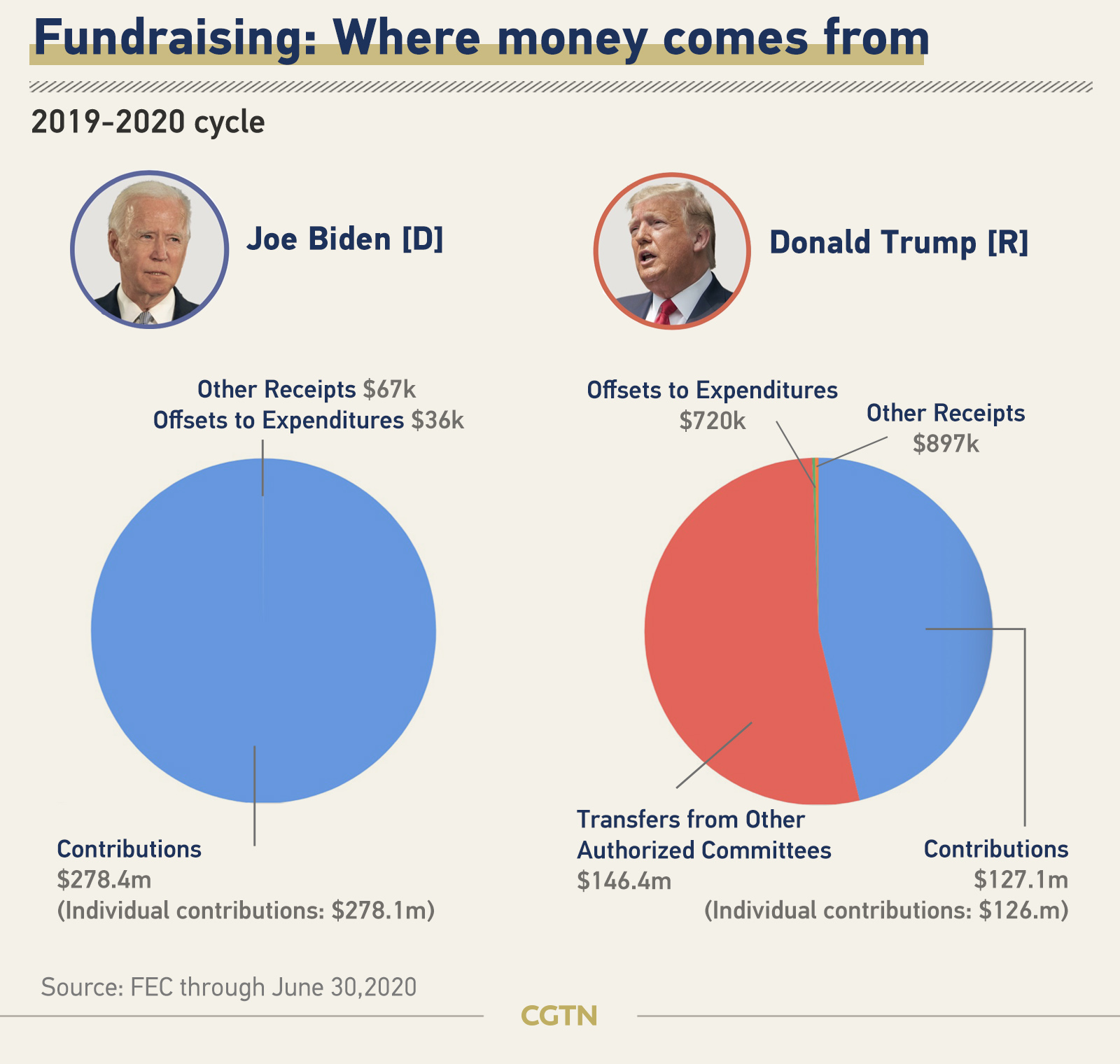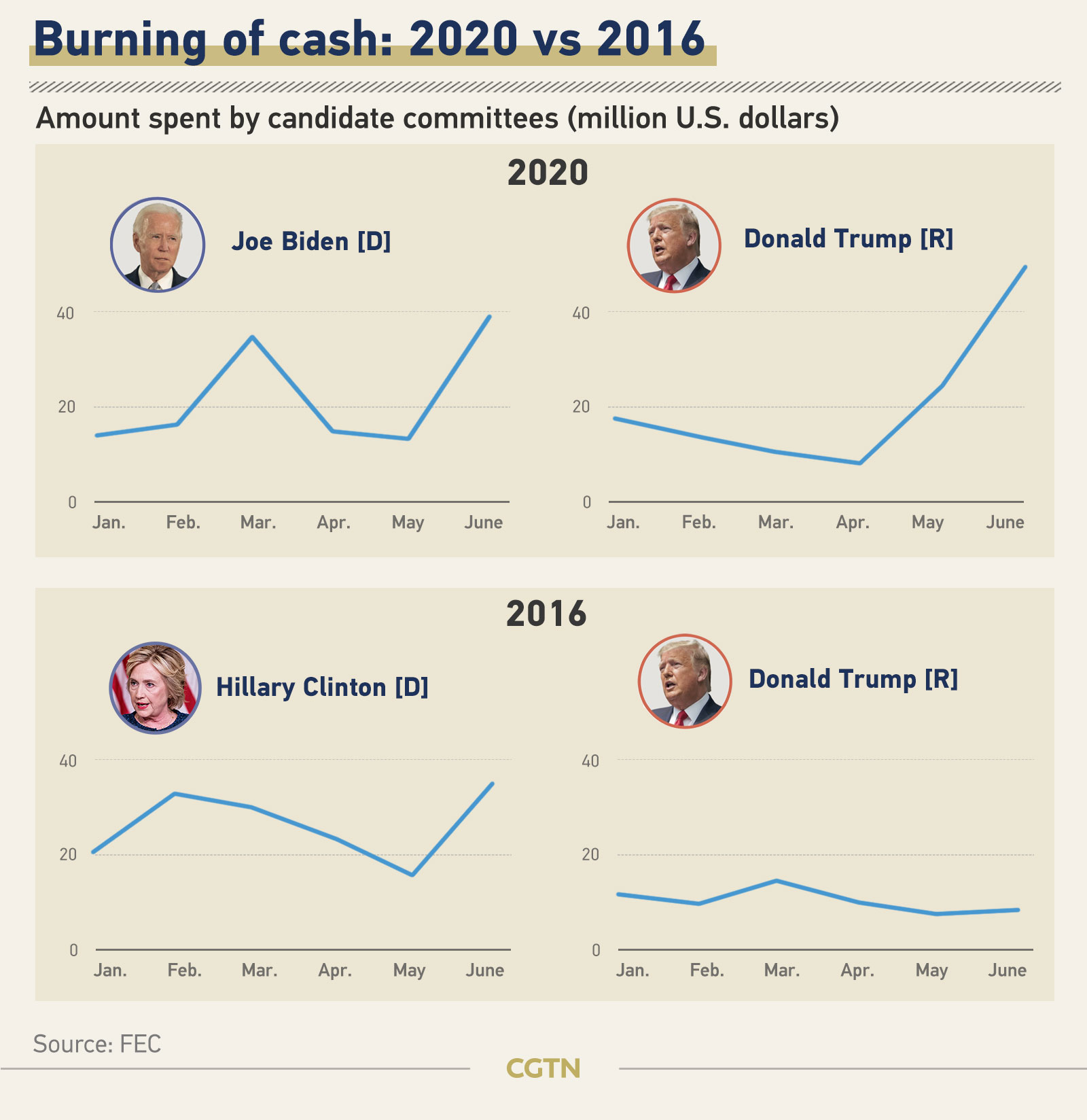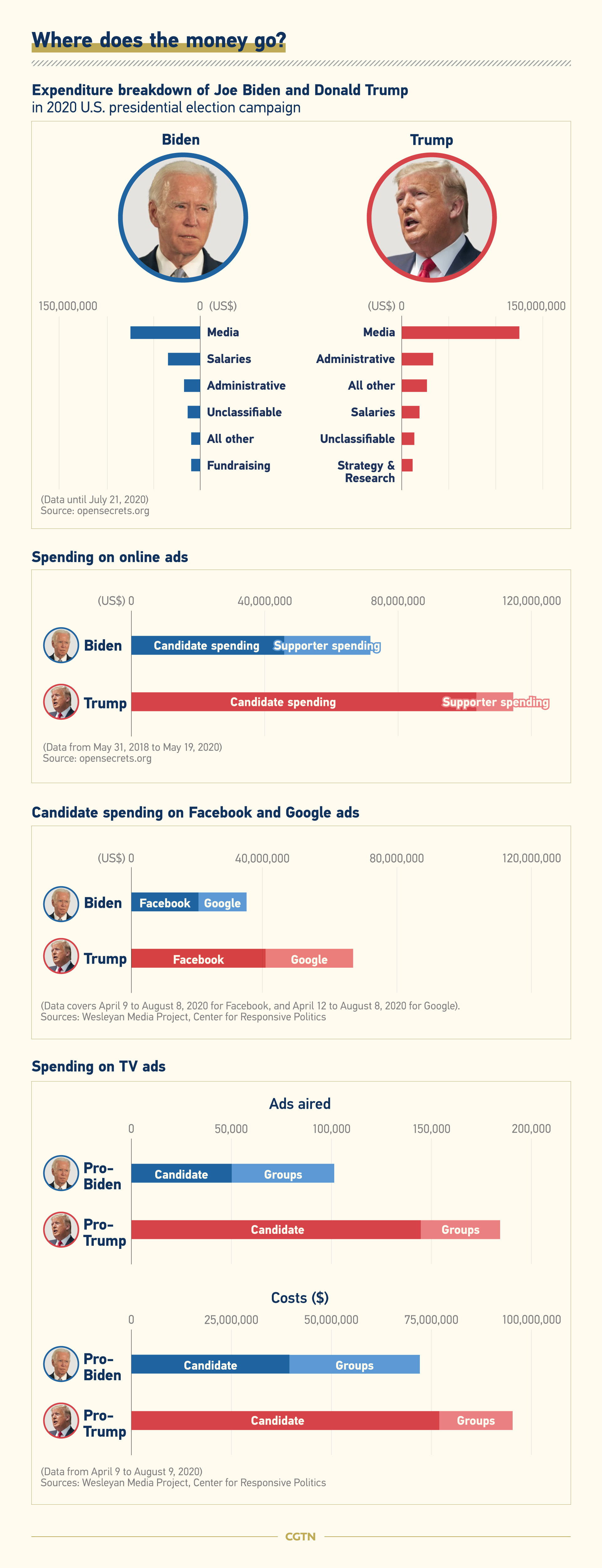Money is a fixture of American elections. But do dollars buy victory?
Not in 2016, when Hillary Clinton outspent Donald Trump by nearly two to one (1.18 billion U.S. dollars to 616.5 million) but lost in the Electoral College.
Total spending on the 2016 presidential race was a staggering 2.4 billion dollars, according to the campaign finance watchdog Open Secrets, a sum that would cover the average salaries of over 30,000 nurses for a year in the United States.
Will even more money be spent in the 2020 election? The total raised by all candidates (including primary challengers, such as billionaire Michael Bloomberg) is already nearing three billion dollars, according to the Federal Election Commission (FEC), with 80 days to go until the November 3 polling day.

CGTN sifted through the data to find out how Democrat Joe Biden and Republican Trump's fundraising efforts compare, where they are spending their money and what it tells us about the race for the White House.
How much has been raised?
Biden struggled to raise big money initially during the Democratic primaries and was repeatedly out-fundraised by rivals Bernie Sanders, Elizabeth Warren, and Pete Buttigieg. However, after securing the party's nomination and improving his finance operation, the donations flooded in.
The 77-year-old raked in a total of 278.9 million dollars to the end of June, a number likely to jump considerably when the next FEC filing is made. Biden claimed 26 million dollars, including from 150,000 first-time donors, was raised in the 24 hours after Kamala Harris was announced as his running mate on Tuesday.
The former vice president has received the most money from donors in California (29.8 million dollars), New York (17.7 million), and Florida (9.5 million), FEC data shows. So far, he has received around half his funds from small-dollar (contributions of under 200 dollars) donors.

Trump, who had problems enticing donors in the early months of his 2016 campaign, has been running for reelection since his inauguration as president in 2017. He has raised 337.8 million dollars, including 275.2 million during a 2019/20 cycle in which he and Biden are close to level-pegging.
The two candidates had over 100 million dollars of cash on hand each at the end of June, ready to ramp up spending in battlegrounds and attack or defend other states as the race progresses.
How much has been spent?
Biden and Trump have spent heavily already, and the rate of the outlay will tick up as polling day approaches.
However, the cash burn rate in 2020 may be complicated by the unique circumstances of the election. The fallout from the COVID-19 pandemic is likely to see many more votes cast before November 3 than in 2016. Absentee ballots will be sent to North Carolinians from September 4, for example, essentially meaning voting begins in just three weeks.
This has multiple potential consequences, including a likelihood that more money is spent in key states earlier than in previous elections, making calculations over the burn rate – and keeping enough cash on hand – even more tricky for the campaigns.

In the first half of 2016, Trump's campaign spent at a relatively stable rate of around 10 million dollars per month. Hampered by a lack of funds and engaged in a primary fight, he was comfortably outspent by rival Hillary Clinton every month. The contrast to the first half of 2020 is stark, with the president dramatically increasing his outlay from nine million dollars in April to over 50 million in June.
Biden contested a broad primary field that narrowed on the eve of Super Tuesday on March 3 and again in the days after the multi-state vote. He raised 46.7 million dollars in March and spent 32.4 million, up from 18.1 million dollars and 13.1 million, respectively the previous month. In June, he accelerated again, to 63.4 million dollars and 36.9 million, respectively.
Overall, FEC data shows the Trump campaign had spent 230 million dollars on the president's reelection bid, and Biden had committed 170 million up to June 30. Outside groups have also spent heavily: Open Secrets reported on August 13 that outside spending had already surpassed 500 million dollars.
Where has the money been spent?
Campaign spending is typically dominated by advertising and staffing costs, but also includes sizeable bills for travel and events. One of the many curiosities of the 2020 campaign is that several smaller costs – such as hiring venues or paying for private flights – will be much lower than in previous campaigns. However, spending in other areas, such as social media, are on course to be dramatically higher.
Notably, Biden has so far spent considerably more money on staffing (35.7 million dollars, according to Open Secrets) than a Trump campaign (15.1 million dollars) that has been criticized for lack of clear direction.
The big spend in any campaign is on media buys, and Open Secrets research suggests Trump has committed 53.33 percent of his campaign expenditure on media compared to Biden's 45.80 percent.

Digital campaigning came of age in 2008 with the Obama team's use of online tools to fundraise and organize and took another leap forward in 2016 when Trump – lacking the cash or campaign structure to match Clinton on TV – poured money into Facebook advertising.
In 2020, the online campaign has taken a new form, with in-person fundraisers and even convention speeches delivered via video call. Both Biden and Trump are also plowing money into digital advertising, though platforms including Twitter and TikTok have now banned paid political ads.
Trump and Clinton spent a combined 81 million dollars on Facebook ads during the 2016 election cycle, according to the social media company, but 2020 is shaping up to be even more lucrative for Mark Zuckerburg's firm. Facebook Ad Library data shows Trump (28.8 million page likes) had already spent 40.9 million dollars on the platform in the year to August 12, almost 10 million dollars more than Biden's (2.4 million page likes) 31.1 million dollars.
In the two years between May 2018 and May 2020, Trump spent over 100 million dollars on online advertising, and Biden, whose campaign began in April 2019, spent a little over 40 million. The Democrat is beginning to catch up, though: he spent almost one million dollars on Facebook ads on Wednesday alone, the day after he announced Harris would be his running mate.
Read more:
Why are deep red states turning blue?
Biden picks Harris: What does it mean for the election?
However, while online advertising is taking up a growing proportion of spending, expensive television adverts continue to dominate campaign costs.
Research by the Wesleyan Media Project in partnership with the Center for Responsive Politics shows that Trump ad buys totaled 76.9 million dollars in the four months to August 9, with 145,014 advertisements aired. Biden buys totaled 39.4 million, with 50,390 ads aired in the same period, though outside groups paid 32.5 million dollars for an additional pro-Biden 50,879 ads.
A closer look at the data suggests the Democrat is shopping in more expensive TV markets and so likely reaching more people with each of his advertisements, even though the number of commercials aired is lower. Between July 14 and August 9, the Biden campaign spent seven million dollars more than Trump 2020 on ads – 29.1 million dollars to 22.3 million dollars – but aired 9,000 fewer.
The target locations of the ad buys indicate the states the campaigns think will be critical to victory in November. More presidential ads were aired in Phoenix, Arizona than any other U.S. city in the four months to August 9, according to Wesleyan Media Project research, followed by cities in Wisconsin, Michigan, Pennsylvania, Florida and North Carolina – the six states identified by Michael Bloomberg as 2020's pivotal battlegrounds.
Trump began the campaign with significant cash and advertising advantage over Biden, but the Democrat is steadily gaining ground in both areas. Heading into the party conventions, Biden has a healthy polling lead over the president, but in terms of money, the candidates are neck and neck.
(Graphics by Chen Yuyang)